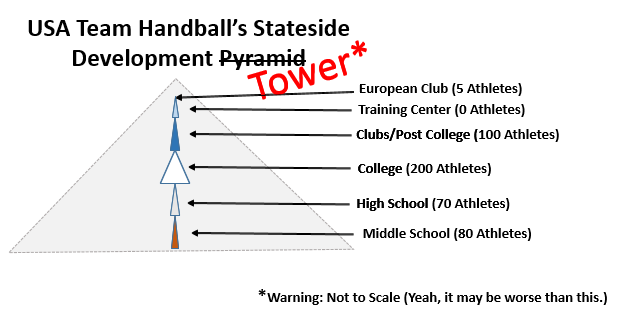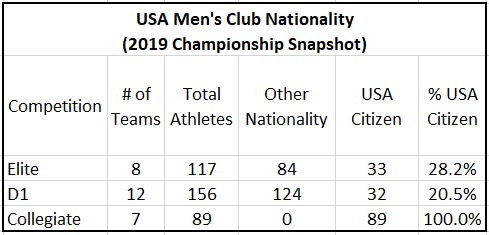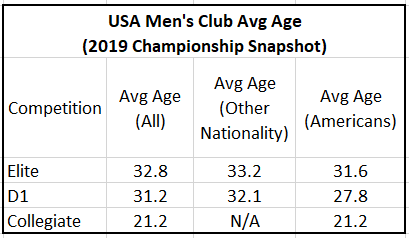
This article is part of a series, Charting a Way Forward for USA Team Handball (2019 Reboot)
A Brief Diatribe on American and European Sports Structures
When describing handball in the U.S., it’s important to contextually to consider one’s audience. Simple terms like club, schools, colleges, intramurals, leagues, tournaments and championships can mean radically different things to a European or an American.
Case in point, I’ll never forget a comical discussion I had with my French basketball teammates regarding what the NCAA basketball tournament was. This “knockout” tournament is a huge deal in the U.S. and was getting a little publicity in France since the son, Joakim, of a famous Frenchman, Yannick Noah, was playing in it. Why was this conversation comical? Because I couldn’t go one sentence without having to backtrack down a rabbit hole with further explanations. Here’s roughly how it went:
Me: So, it’s a tournament to determine the college national champion
Teammate 1: What kind of a tournament?
Me: Well, it’s a tournament where the top 64 teams keep playing each other until only 1 team is left
Teammate 2: Oh, so like the Coupe de France.
Me: Well, no it is just for college teams and it’s played over 3 consecutive weekends.
Teammate 3: College teams? Huh, Why not the NBA and the 2nd division below the NBA.
Teammate 4: No, Claude. They don’t have divisions in the U.S. College is their 2nd division.
Me: Well, sort of, but not exactly. It’s our 2nd best competition, but the players are amateur and only get scholarships.
Teammate
5: What’s a scholarship?
So… I could go on and on and the conversation actually did for another 15 minutes or so, but it was really stretching my French speaking skills. Still, even if I had been fluent it would have been a huge challenge. Also, the funny thing was that since by that time I had lived a few years in France I fully understood why they had asked each and every question.
It was also revelatory to me about all the expats I had played handball with in the U.S. No wonder they were so confused. Our structures are so different in so many ways and what I’ve learned is that each culture takes so many things for granted simply because… Well, that’s the way it’s always been done.
So, if you’re wondering why the obvious is being explained, keep in mind I’m writing for two different audiences.
Men’s Team Handball Organizations and Activities in the United States
Training Centers: A Training Center is a place where handball is taught intensively. Two common examples: A European style Academy and what the U.S. has called Residency Programs in the past. Currently, there are no handball training centers in the U.S., although the youth program in Chicago has some elements of an Academy, albeit on a smaller scale.
Clubs: There are approximately 40 adult men’s clubs in the U.S. These clubs vary significantly in terms of size, organization and level of play. At one end of the spectrum is the New York City Team Handball Club with dozens of members, most of whom have played before in another country. At the other end of the spectrum are perhaps around 10 clubs that have maybe 5-10 dedicated players and are struggling to keep afloat. With few exceptions U.S. clubs are also simply adult recreational clubs. There are no youth teams progressively teaching more skills as athletes get older. The adult members do take the sport seriously, but practices are at most once or twice a week with competition limited to weekend tournaments. The one exception to this is North East Team Handball League.
Collegiate Clubs: An important subset of clubs are collegiate clubs which are affiliated with a college or University. There are roughly 13 Men’s collegiate clubs in the U.S. It should also be emphasized that collegiate club sports are dramatically different from sanctioned NCAA sports. There are no scholarships and colleges typically only provide top level support. As athletes are college students, in most instances they are ages 18-23.
Youth Programs: These programs consist of athletes in Middle School (ages 12-14) and High School (ages 14-18). There are two fairly well established programs in the U.S., one in San Francisco with roughly 130 participants and one in the Chicago area with roughly 20 participants. The program in San Francisco is a school based competition while the Chicago program is focused around one athletic facility.
Other Activities: Team handball is played in Physical Education classes in hundreds, maybe even thousands of schools. This handball, however, is often just a rough facsimile of the game, taught by teachers unfamiliar with the sport, for a few lessons and with a lot of rule variants. There are also a number of colleges with intramural programs. (Intramural sports are lower level competitions where multiple teams at one college play each other.) Again, the handball that is played is often just a facsimile of the game we are all familiar with.
USA Men’s Club Demographics (2019 National Championship Snapshot)
This past April and May the U.S. staged its Collegiate Club and Club National Championships. Unlike European countries there is no nation-wide league and these championship events are played over only 3 days and are open to all comers. 3 Canadian clubs even attended. This chart breaks down the total participants in these 3 events.


(Note: Club nationals
had 2 separate competitions: Elite and Div 1)
(Note: Citizenship data in these tables
relied heavily on roster names to assess nationality. Such an assessment surely is prone to error
as Americans don’t always have “American Sounding” names and conversely some
expats have deceptively “American Sounding” names. Overall, though I would assess that it’s a
pretty good ballpark data.)
A few obvious points from these tables.
- A majority of our Club National Championships participants are not U.S. citizens (Only 23% of the combined total of Elite/D1 Male athletes were U.S. citizens)
- A majority of our Club National Championships participants are over the age of 30
- An overwhelming majority of our College National Championship participants are U.S. citizens
- An overwhelming majority of our College National Championship participants are younger than 24 years old.
U.S. Citizen Demographics (Male)
In terms of National Team planning it is, of course, a necessity to focus strictly on U.S. citizen demographics. The following tables break out the citizen representation from U.S. clubs and adds estimates for expat Americans playing overseas and youth program participation. These estimates were based on an extrapolation of National Championship data and National Team roster data. For USA based numbers I added athletes based on known clubs that didn’t attend nationals. For overseas numbers I took the number or expat players that have played on Sr, Jr, and Youth rosters the past 10 years or so (60 total) and doubled it, figuring that would conservatively account for unknown or lower level players. Anecdotally, I would assess that the yearly total is higher at younger ages and gets significantly smaller as players age out. For the most part I tried to error on the conservative side. The only exception is that I did not pad this data with the inclusion of school Phys Ed programs and college intramurals.

Key Points and Logical Follow On Questions:
- Conservatively, there are less than 600 Male U.S. citizen handball players in the world. (It depends on one’s semantics, but it’s probably less.)
- Question: Should USA Team Handball’s top priority be increasing this very, very low “total number”?
- Stateside demographics clearly do not follow the traditional pyramid structure often seen with other sports (massive youth participation at the base and professionals/national teams at the tip.)
- Question: Is not having a pyramid a problem?
- Question: How should limited resources be applied to different levels of this would be pyramid
- The only level with a competition that is structured somewhat normal (right age; predominantly American) is our college championships.
- Question: Why is there some level of success at this level?
- Question: Can this success be duplicated at other levels of the pyramid? Why or why not?
This is meant only as a top level analysis. In a future article I will take a closer look at the U.S. Elite Player Pool and the existing and potential pathways for athletes to enter this pool.